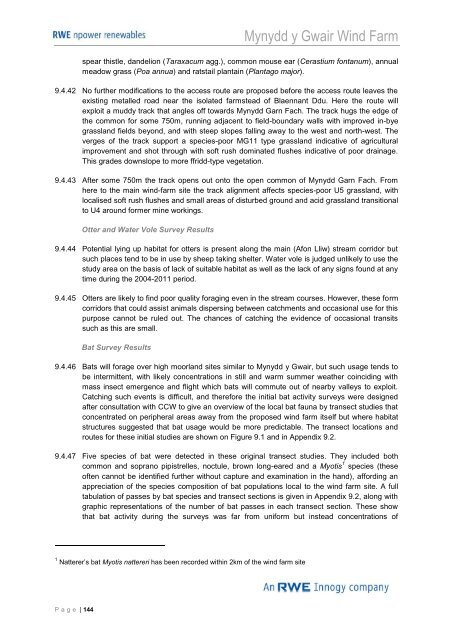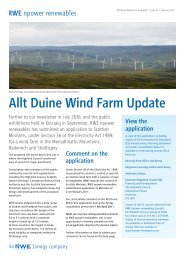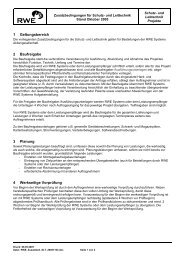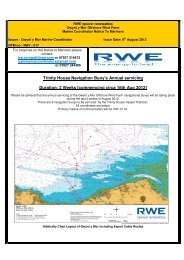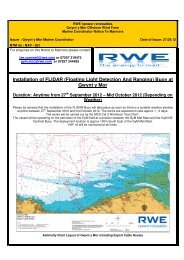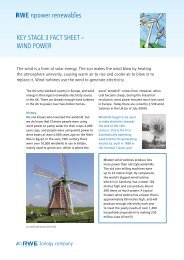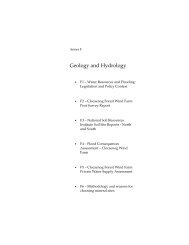Mynydd y Gwair Wind Farm - RWE.com
Mynydd y Gwair Wind Farm - RWE.com
Mynydd y Gwair Wind Farm - RWE.com
Create successful ePaper yourself
Turn your PDF publications into a flip-book with our unique Google optimized e-Paper software.
P a g e | 144<br />
<strong>Mynydd</strong> y <strong>Gwair</strong> <strong>Wind</strong> <strong>Farm</strong><br />
spear thistle, dandelion (Taraxacum agg.), <strong>com</strong>mon mouse ear (Cerastium fontanum), annual<br />
meadow grass (Poa annua) and ratstail plantain (Plantago major).<br />
9.4.42 No further modifications to the access route are proposed before the access route leaves the<br />
existing metalled road near the isolated farmstead of Blaennant Ddu. Here the route will<br />
exploit a muddy track that angles off towards <strong>Mynydd</strong> Garn Fach. The track hugs the edge of<br />
the <strong>com</strong>mon for some 750m, running adjacent to field-boundary walls with improved in-bye<br />
grassland fields beyond, and with steep slopes falling away to the west and north-west. The<br />
verges of the track support a species-poor MG11 type grassland indicative of agricultural<br />
improvement and shot through with soft rush dominated flushes indicative of poor drainage.<br />
This grades downslope to more ffridd-type vegetation.<br />
9.4.43 After some 750m the track opens out onto the open <strong>com</strong>mon of <strong>Mynydd</strong> Garn Fach. From<br />
here to the main wind-farm site the track alignment affects species-poor U5 grassland, with<br />
localised soft rush flushes and small areas of disturbed ground and acid grassland transitional<br />
to U4 around former mine workings.<br />
Otter and Water Vole Survey Results<br />
9.4.44 Potential lying up habitat for otters is present along the main (Afon Lliw) stream corridor but<br />
such places tend to be in use by sheep taking shelter. Water vole is judged unlikely to use the<br />
study area on the basis of lack of suitable habitat as well as the lack of any signs found at any<br />
time during the 2004-2011 period.<br />
9.4.45 Otters are likely to find poor quality foraging even in the stream courses. However, these form<br />
corridors that could assist animals dispersing between catchments and occasional use for this<br />
purpose cannot be ruled out. The chances of catching the evidence of occasional transits<br />
such as this are small.<br />
Bat Survey Results<br />
9.4.46 Bats will forage over high moorland sites similar to <strong>Mynydd</strong> y <strong>Gwair</strong>, but such usage tends to<br />
be intermittent, with likely concentrations in still and warm summer weather coinciding with<br />
mass insect emergence and flight which bats will <strong>com</strong>mute out of nearby valleys to exploit.<br />
Catching such events is difficult, and therefore the initial bat activity surveys were designed<br />
after consultation with CCW to give an overview of the local bat fauna by transect studies that<br />
concentrated on peripheral areas away from the proposed wind farm itself but where habitat<br />
structures suggested that bat usage would be more predictable. The transect locations and<br />
routes for these initial studies are shown on Figure 9.1 and in Appendix 9.2.<br />
9.4.47 Five species of bat were detected in these original transect studies. They included both<br />
<strong>com</strong>mon and soprano pipistrelles, noctule, brown long-eared and a Myotis 1 species (these<br />
often cannot be identified further without capture and examination in the hand), affording an<br />
appreciation of the species <strong>com</strong>position of bat populations local to the wind farm site. A full<br />
tabulation of passes by bat species and transect sections is given in Appendix 9.2, along with<br />
graphic representations of the number of bat passes in each transect section. These show<br />
that bat activity during the surveys was far from uniform but instead concentrations of<br />
1 Natterer‟s bat Myotis nattereri has been recorded within 2km of the wind farm site


